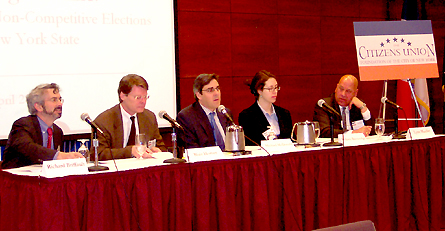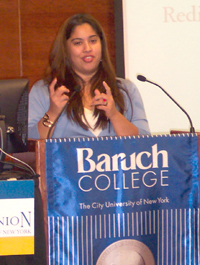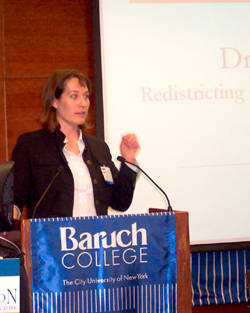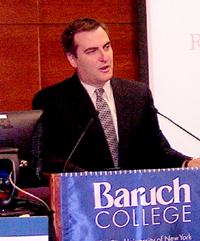
Drawing the Line: Redistricting and Non-Competitive Elections in New York State was a forum held by Citizens Union Foundation (which publishes Gotham Gazette) and the School of Public Affairs at Baruch College on Friday April 28, 2005. The following are excerpts from discussions at the forum.
SHOULD LEGISLATIVE DISTRICTS BE REDRAWN TO ENCOURAGE COMPETITION?
Jeremy Creelan (Brennan Center for Social Justice): We have demographic realities that mean that for the most part our general elections are not competitive in New York City, and they're not competitive upstate. [Therefore], when you talk about wanting competition, you have to talk about what the goal actually is. Competition sounds good, and theoretically it has been shown to increase voter involvement and some elements of accountability, but it might be more important to focus on other elements of political power -- or at least consider them at the same time.
Henry Stern (New York Civic): Isn't the only totally non-partisan way to do districting to make it on a geographic basis?
When you go into considerations like giving advantage to party, or giving advantage to an ethnic group, or an interest group, or a disenfranchised group, don't you then impose extra burdens, privileges, or priorities on a scheme of theoretically disinterested neutral, geographic redistricting?
Steve Carbo (DEMOS): You and I might have a disagreement about the purpose of redistricting and representation. I question the ultimate and fundamental and democratic value of drawing lines according to geographic county lines as being the “end all and be all” of redistricting. In my mind, the goal of redistricting and the election process is to give the different interests that reside in that state, and that are represented by its voters, a fair opportunity to have their interests represented by their elected officials. [They should] have their interests and agenda advanced by those that they elect. That means that you end up looking not only at county boundary lines, but where people live and what are people's preexisting opportunities for fair representation. There are factors that go into this process; it is not a clean one that is best served by drawing the straightest and narrowest lines that are possible.
Lucia Gomez (Cuban American National Council): Just to think of the purity of it all – the goal is to give every person equal access to vote. Everyone has the same right as the next person, and his or her vote is worth the same thing.
There is a demographic reality, though: New York City has changed. There are not many districts Latinos need to strive for, draw, or gerrymander lines, to capture a district that is majority Latino. But because demographics change, we need to begin to understand and define what competitiveness is. In New York City, we're not going to begin to try to draw districts that are competitive between Democrats and Republicans…
…When we talk about the criteria, [we may need to] go beyond the criteria we have already set. We need to begin to see that how demographic realities make it difficult to abide by old criteria like not crossing county lines.
Rachel Leon (Common Cause New York): One of the ways we define competitiveness is regular people being able to run for office for these races. One of the problems when you don't have compact districts is it makes it so much more difficult to mount a challenge. The further you have to go, the notion of door-to-door grassroots campaigning gets lost. Ultimately we want regular people to run for office.
EJ McMahon (Manhattan Institute): I don't think the kind of competitiveness that we would like to encourage is the kind that entails stretching the Upper West Side into a district with someone with Saratoga Country. I think that compact and contiguous districts [is appropriate] as a goal. There are people in this room – I among them – who live in one form of community of interest that stretches around the globe via the internet. There are other people who share interest with people in Ithaca in terms of political ideology. However, the organizing principle of our community is the place where we live. There are no guarantees in life, but compact and contiguous is the most competitive.
Also, when you have large, ungainly geographically huge districts, it's very hard to recruit candidates. It's very hard to get five or six county committees to choose a candidate for state assembly. Compact and contiguous is a very good organizing principle if you want competitive elections.
Jeremy Creelan (Brennan Center for Social Justice): There's a distinction between taking the self-dealing out of the redistricting process by saying someone other than the legislators should be drawing the lines and requiring competitiveness. A redistricting commission in New York could produce lines that are entirely non-competitive, but yet we have all sorts of positive impacts of that, that we can't fully tease out today.
EJ McMahon (Manhattan Institute): A process that is indifferent to competitiveness will produce the result of competitiveness. If the process is focused on organizing districts around natural communities, it will be more competitive. I want that to happen because I want it to be more competitive, but I'm not saying that competitiveness is the principle that guides the drawing of the map.
Nicole Gordon (New York City Campaign Finance Board): This is not about turning incumbents out; it's about making sure that they have something to worry about because anybody who has done service for the community has an opportunity to make a meaningful case that they could do better.
When you talk about redistricting you are talking about general elections. I've always wondered whether it doesn't satisfy the notion of competitiveness that if you can have at least a competitive primary or at least a competitive general election, you may have satisfied some of the issues that are raised. You're not going to turn the Upper West Side into a Republican district very soon. But what you can have is a very lively primary, so at least you have a way for the incumbent to worry about serving the community.
Jeremy Creelan (Brennan Center for Social Justice): If a legislator wins or loses, he or she should win or lose for the right reasons. In my mind, that boils down to making sure that the reason is not because a line is drawn to make sure that he does win. There are other things too – you're making sure that he or she does not win because the campaign finance rules are rigged. To me, that is the ultimate test. You want [elected officials] to have a sense that they have to face whatever competitiveness and accountability the system allows.
Rachel Leon (Common Cause New York): Redistricting, in and of itself, is not a magic bullet. You have other things you need, like campaign finance, like legislative rules, like ethics. Ideally, the combination of those then gives you a healthy democracy where legislators are debating the issues of the day and responding to public concerns. That is ultimately what we want.
DISENFRANCHISING POLITICAL MINORITIES
EJ McMahon, director of the Manhattan Institute's Empire Center for New York State Policy
 I live in a Senate district whose shape Blair Horner of New York Public Interest Research Group has described as “Abraham Lincoln Riding on a Vacuum Cleaner,” and an Assembly district that stretches well over 100 miles and straddles four or five counties.
I live in a Senate district whose shape Blair Horner of New York Public Interest Research Group has described as “Abraham Lincoln Riding on a Vacuum Cleaner,” and an Assembly district that stretches well over 100 miles and straddles four or five counties.
Large ungainly districts deter challenges. This is a real problem for the minority party. Political organizations are organized on a county level. When you have slices of four or five counties in an assembly district, it complicates candidate selection immensely.
By creating entrenched political minorities and further strengthening the hands of very powerful leaders, this has weakened political minorities in the legislature. This is an area in which New York is exceptional. The minority parties in both the Senate and the Assembly –but especially in the Assembly because the margin is so one-sided – are effectively disenfranchised, and their constituents are disenfranchised. There is an enormous disparity in the distribution of resources to minority members, and the parliamentary rules are rigged against meaningful participation by the political minorities. Indeed, two members of legislative minorities – Democrat Liz Krueger in the Senate and Republican Tom Kerwin in the Assembly – are pursuing a lawsuit to challenge that situation. I frankly don't think it has much chance at producing a result.
If we had an honest redistricting process, there would be a more liberal cast to the Senate. On the other hand, in the Assembly, there is a considerable segment of members from both parties who are temperamentally and politically more moderate to conservative, especially on fiscal issues, but who are now invisible. With redistricting, you might actually see the emergence of a working majority that is more moderate to conservative on fiscal and tax issues. You would have a breaking of the majority.
The single most important thing to bring change is to hold the gubernatorial candidates’ feet to the fire on stopping their cooperation with the current redistricting process. This is totally within the hands of the governor to stop.
WHY NONPROFITS ENCOURAGE GERRYMANDERING
Lucia Gomez, Cuban American National Council
 I participated in a redistricting process with the Puerto Rican Legal Defense Fund, and got to see redistricting on two different levels in terms of nonprofits.
I participated in a redistricting process with the Puerto Rican Legal Defense Fund, and got to see redistricting on two different levels in terms of nonprofits.
First, I worked on was to organize people at the local level to participate in the redistricting process, with the goal of helping draw districts that they thought were beneficial to their neighborhoods. To do so the boundaries should realistically reflect their geographic communities and social service needs. That was my primary goal.
The other level was to work with individuals in the Latino community, helping them understand how redistricting plays out in the way in which their neighborhoods vote, their level of civic engagement, and the way money is distributed. I wanted them to understand how redistricting was a fundamental component of whether adequate money came into the neighborhood to fund social services.
Through this work, I learned to see the way nonprofits engage in the political process through a different lens. Nonprofits were really playing a political role for incumbents, in which incumbents were using these groups to argue for why their districts should be drawn the way they were.
At first, I thought the nonprofits didn't know what was happening. I thought I was educating them so they could see that they could leverage additional support by drawing districts that were competitive and that really gave the voters an opportunity to elect candidates of their choice.
But I started seeing how the elected officials were playing the nonprofits to their advantage, knowing exactly what they were doing. And the nonprofits knew exactly what they had to do in order to get what they wanted out of their elected representative. Nonprofits and social service organizations rely so heavily on contracts that are provided by state agencies that they don't know any other way of having a relationship with their elected official other than doing whatever that elected official wants. A lot of our nonprofits are being used – and they love being used so they can keep their budgets going, supported by the very incumbents [they help keep in office through gerrymandering].
THE WAY WE COUNT PRISONERS IS A CRIME
Maggie Williams, project director of the Bronx Defenders' Voter Enfranchisement Project
 Because of the Rockefeller Drug Laws, 16,000 people are incarcerated right now in New York State for drug offenses. Of those, 80 percent have never committed a violent felony. So we are talking about low-level users and low-level pushers. And 92 percent of those who are incarcerated for drug offenses are Latino and black.
Because of the Rockefeller Drug Laws, 16,000 people are incarcerated right now in New York State for drug offenses. Of those, 80 percent have never committed a violent felony. So we are talking about low-level users and low-level pushers. And 92 percent of those who are incarcerated for drug offenses are Latino and black.
I take as given that the drug laws are incredibly racist, but they also connect to prisons and redistricting.
Communities of color are being targeted by law enforcement. Individuals get locked up for these low-level drug crimes, and they lose their right to vote. So then you have folks, who in New York State, cannot vote while they are incarcerated and while they are on parole. Meanwhile, they are shipped upstate to white, rural communities, where they are counted in the census.
All these districts upstate are able to count these prisoners in their population, even though prisoners are not able to vote there. There are seven State Senate districts right now that would not meet the minimum number of residents required for a state senate district were it not for the prison population that they are counting.
Of those senate districts, two state senators – Michael Nozzolio and DaleVolker -- are on state senate committees that are the so-called tough on crime committees. They are the forces that oppose, most vociferously, any change to the Rockefeller drug laws.
So, it is a really powerful cycle to say the least: upstate legislators are actually able to hold onto their seats because of the prisons in their district -- and they are very aware of it.
I think there are two ways that New York can deal with this. One, New York, can actually become a voice in advocating for how the census counts prisoners, because that is where the issue originated. Or, New York can choose not to base its legislative districts solely on census count.
A PLAN FOR REFORM
Michael Gianaris, State Assembly Member representing the 36th District in Queens
 In the last state legislative elections, in 2004, 25 percent of state legislators had no opposition. None. Voters went into the booths and had no choice to make. Not just another major party, but no choice whatsoever. No Green Party, no Marijuana Reform Party, nothing.
In the last state legislative elections, in 2004, 25 percent of state legislators had no opposition. None. Voters went into the booths and had no choice to make. Not just another major party, but no choice whatsoever. No Green Party, no Marijuana Reform Party, nothing.
The number of legislators who had competitive races against opponents who had enough resources to make their case to the voters is even more surprising. Almost 60 percent of us didn’t have an opponent who raised even $1,000 for their campaign, which means effectively there was no election in those districts.
What this means is we are in a situation in New York where most of the state legislature is getting re-elected without the voters picking them or even stating, “I like the job the incumbent is doing and I want him re-elected.” We’re depriving voters of their voices because we have a system based on non-competitive elections.
Much of this is due to gerrymandering. The New York State constitution says that the New York legislature shall determine the district lines, so if we are going to reform the redistricting process, we have to do it by legislation. As a result, I am proposing legislation to set up an independent redistricting commission to deal with this problem.
REFORM GOALS
Now what is the objective? I don't want to force competitiveness by somehow creating districts just as gerrymandered or just as bastardized as the ones we are dealing with today so that there is an equal split among the parties. That to me doesn’t make things fair.
But I think we would go a long way if we just set up a process that no longer tried to remove competition from the process. We have a system now where the legal and stated goal actually is to reduce competition. If we just take that out of the equation, we wouldn’t need to worry too much about making sure Democrats and Republicans have an even numbers in every district, because you would end up getting competition de facto in that kind of a situation.
The real goal is compactness, keeping communities together, and letting the chips fall where they may. If 90 percent of the people in a particular area are Democrats, let them elect a Democrat. But at least let them have a choice when they are doing that -- either in the primary or in the general election.
I want to use different criteria for redistricting, and change the purposes for which we draw the lines right now. The most important part is the language that says "no district shall be drawn with an intent to favor or oppose any political party or any incumbent federal or state legislator." Right now that is probably the single greatest purpose for which those lines are drawn.
AN INDEPENDENT COMMISSION
My bill sets up a commission which will use these criteria to draw new district lines. It must be independent. If you set up a commission and it is created directly by the people who you are trying to remove from the process, it doesn't help very much. We tried to create several layers between the appointing authorities and the commission members.
The legislature will have the final vote on approving the commission's decision. But it must vote either up or down, with no opportunity for amendment.
This plan is ambitious; it's difficult. We do have over 30 sponsors on the bill, and we are making some progress in the Assembly. I think the fact that we have six years until the next reapportionment works in our favor. It is allowing us to build some momentum. The gubernatorial candidates are stating their desire for an independent commission. My hope is that the legislature will see the writing on the wall and try to solve this problem ourselves before we get to 2012.
Â




